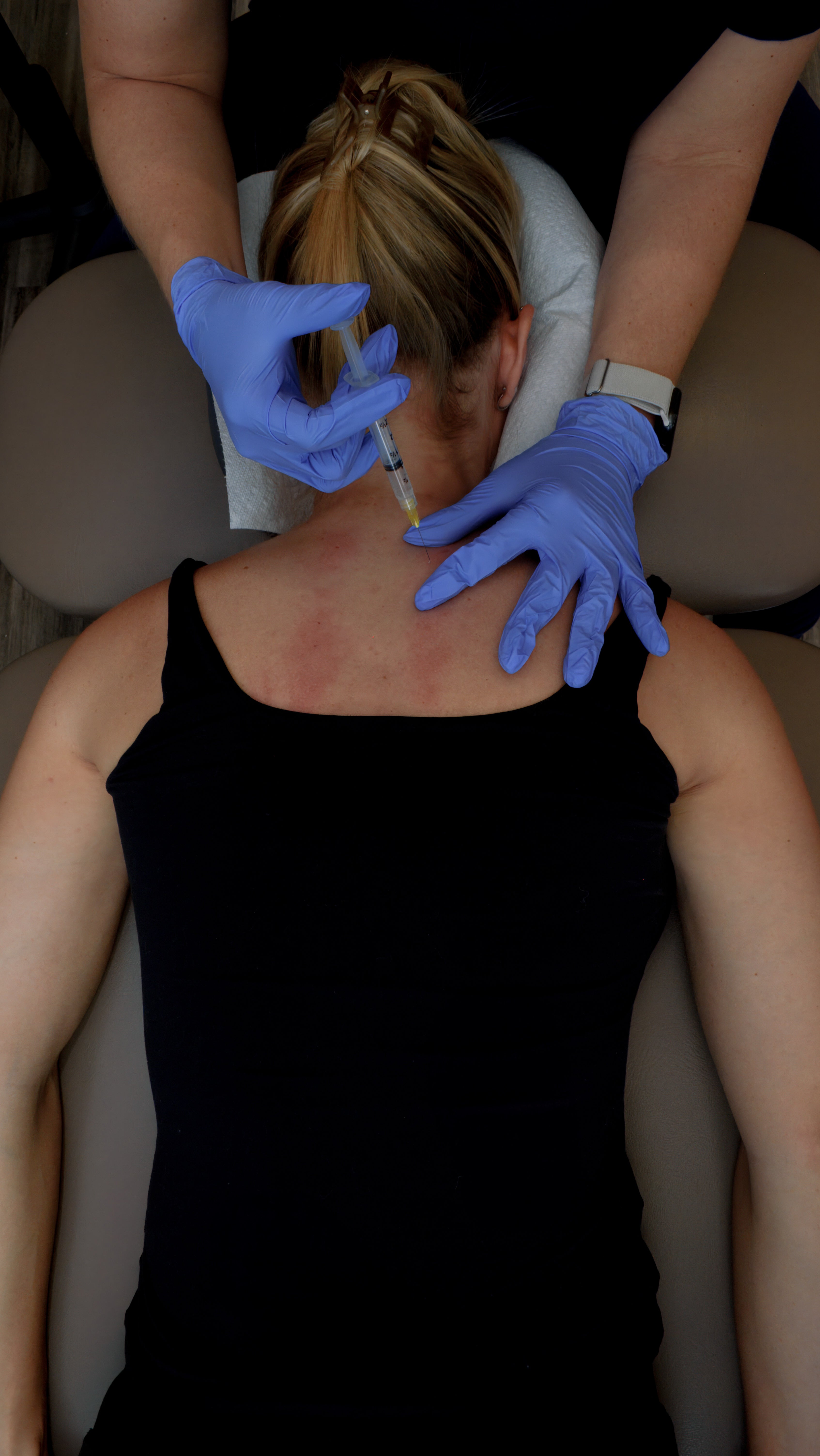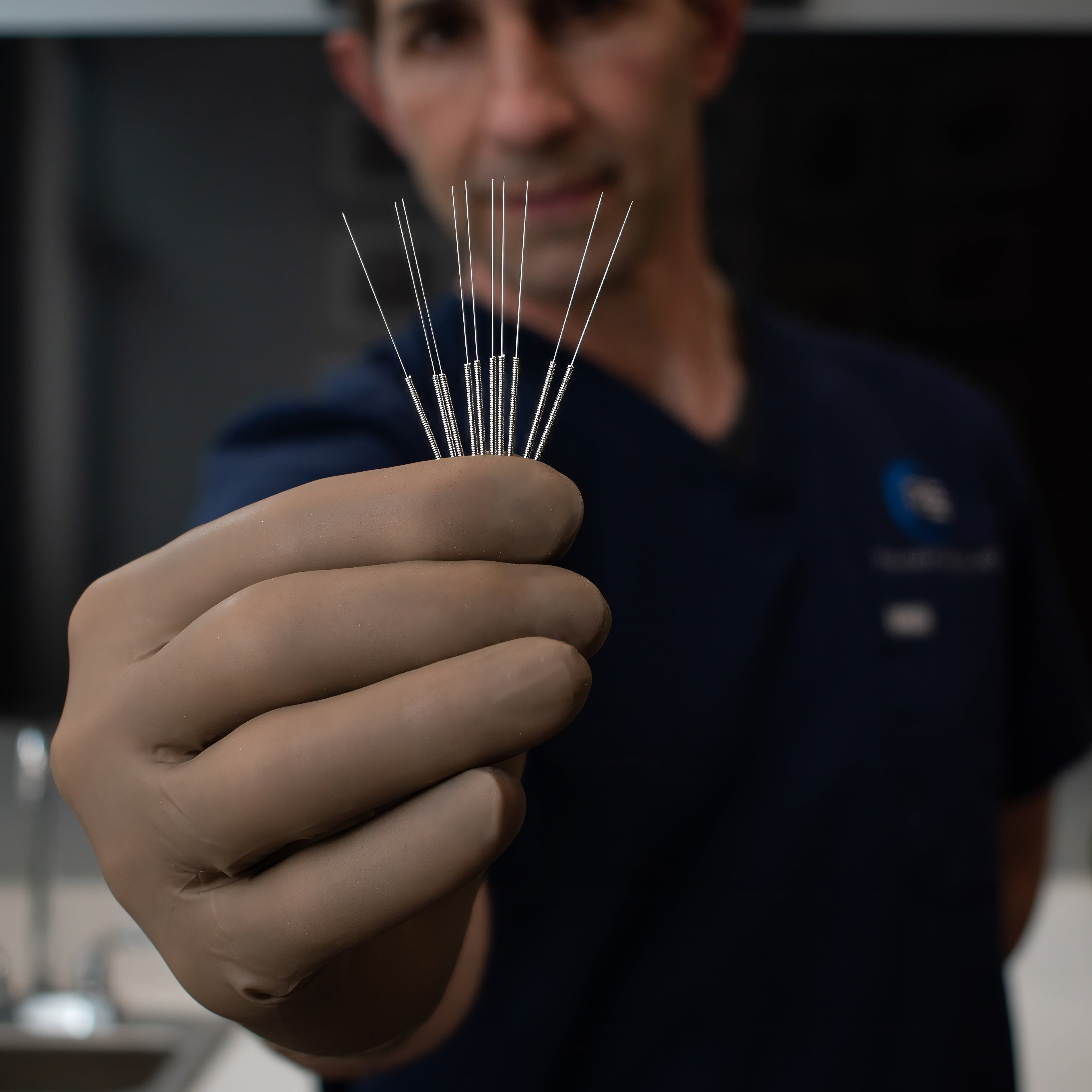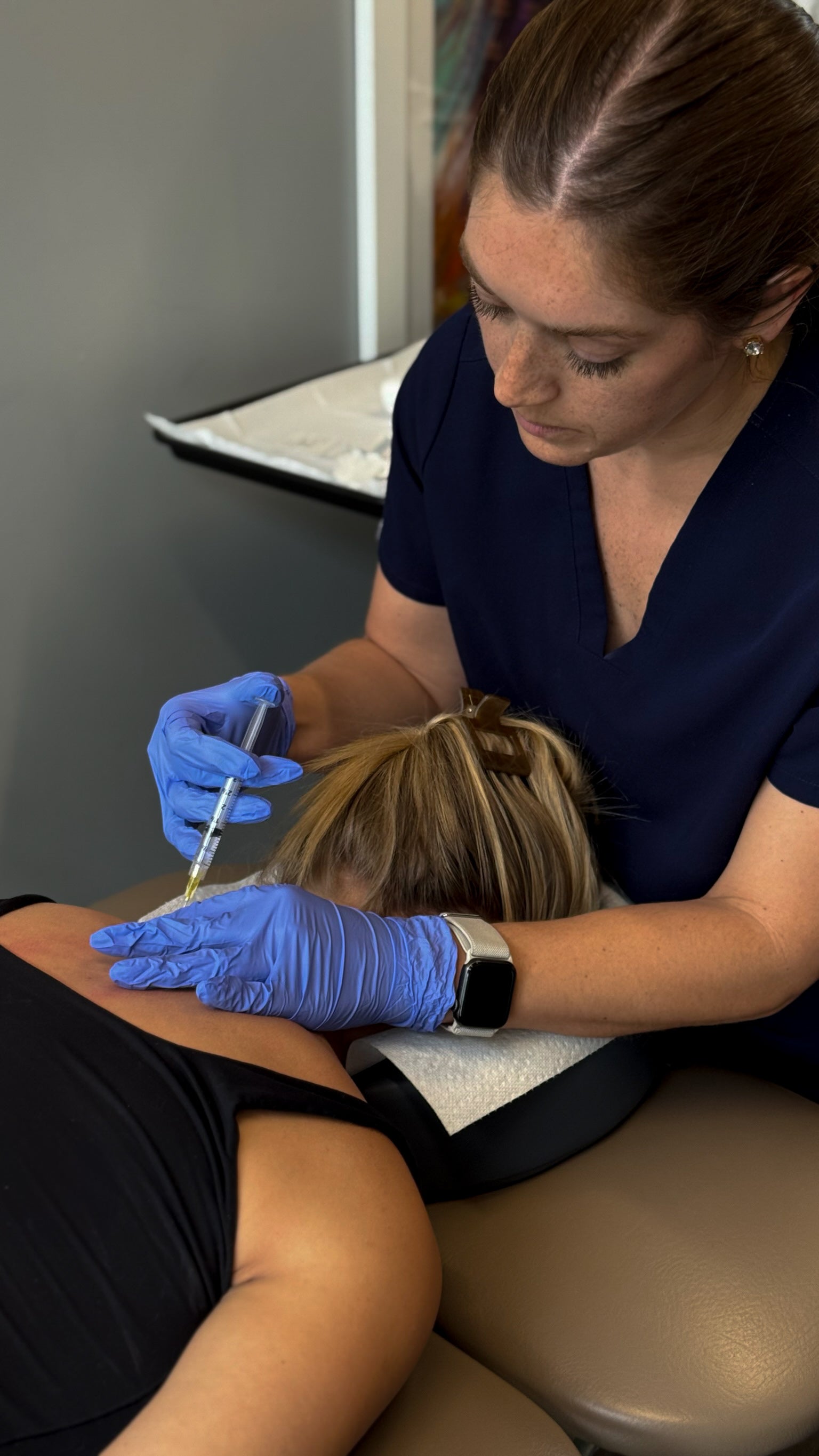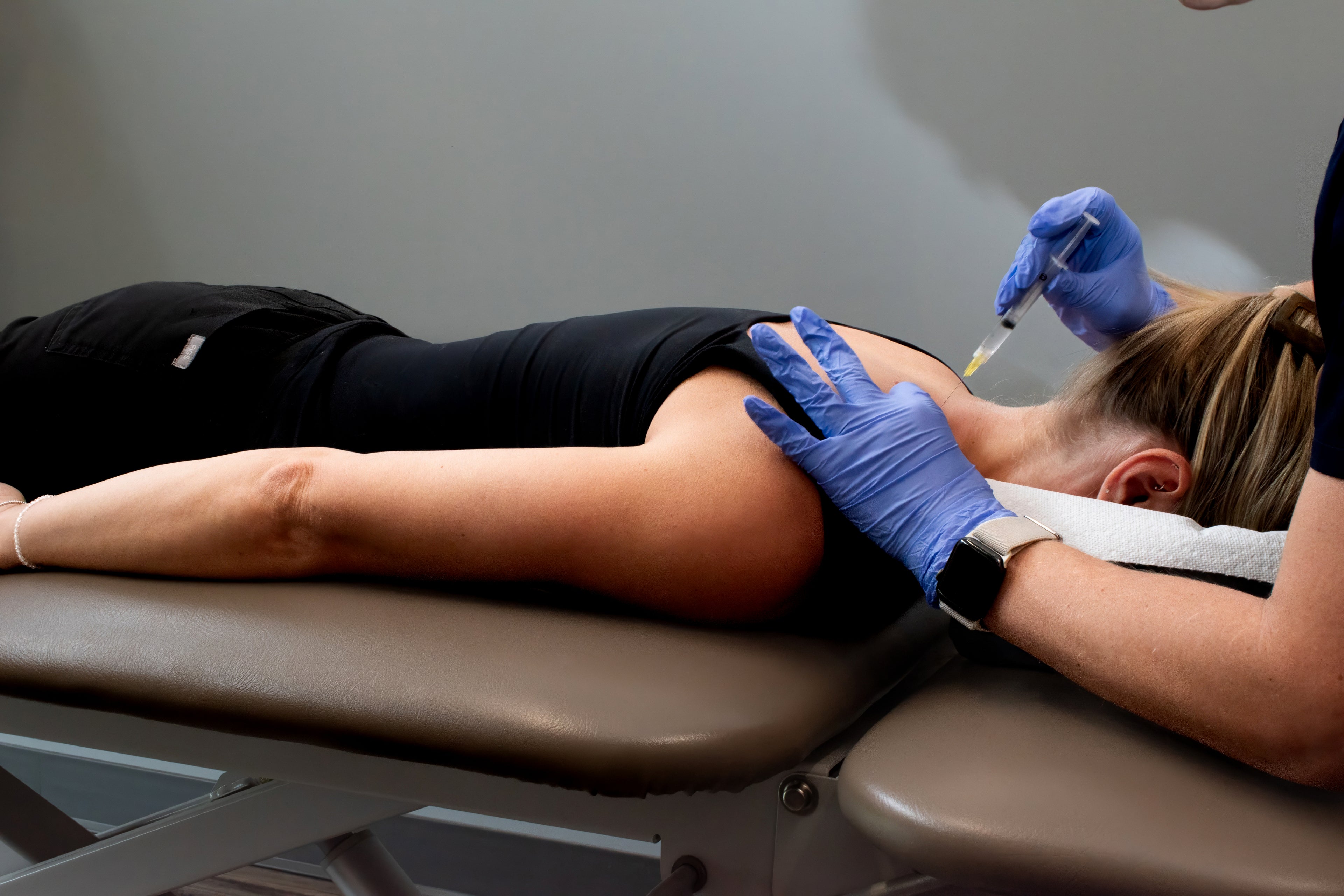

trigger point injections
& Dry Needling
A TARGETED APPROACH TO MUSCLE PAIN RELIEF
At Regeneration Pittsburgh, we specialize in effective, non-surgical treatments that address muscle dysfunction at the source. Whether you’re dealing with chronic pain or recovering from an injury, our needling therapies are designed to restore range of motion and help you stay active—without relying on medication.
Using precision techniques like dry needling and trigger point injections, we target areas of muscular tension to release tightness, improve blood and lymphatic flow, and restore proper nerve function. The result is lasting relief that supports your movement and your lifestyle.
Trigger Point Injections and dry needling


Trigger Point Injections
Whether you are a competitive body builder or spend long hours at a desk, you're likely familiar with muscle knots—commonly referred to in clinical terms as trigger points. These are small, tight areas of muscle spasm that form when muscle fibers become overly contracted and are unable to fully relax. The result is a micro "choke point" that can restrict blood flow, irritate nearby nerves, and contribute to localized or referred pain.
Trigger points are often found in high-tension areas like the neck, shoulders, and lower back, and can significantly impact mobility and comfort if left untreated.


Dry Needling
Dry needling is often mistaken for acupuncture, but while both techniques use the same type of thin filament needle, their purpose and approach are quite different. Acupuncture is rooted in traditional Chinese medicine and focuses on restoring energy balance for overall wellness. Dry needling, on the other hand, is more of a modern therapy
used specifically to address musculoskeletal dysfunction.
The goal of dry needling is to "reset" overactive or dysfunctional muscles by releasing deep-seated tension, improving mobility and stability, and reducing muscular hypersensitivity. Unlike trigger point injections—which involve the use of medications such as lidocaine or saline—dry needling relies solely on mechanical stimulation to relieve pain and restore proper muscle function.
By targeting trigger points and areas of neuromuscular irritation, dry needling helps reestablish healthy movement patterns and supports long-term, pain-free mobility.
What Conditions Can Trigger Point Therapy Help Treat?
Trigger point therapy can be highly effective for a wide range of conditions caused or worsened by muscle tightness, restricted range of motion, and neuromuscular imbalance. Because tight or overactive muscles can affect posture, joint function and even organ systems, treatment often provides relief far beyond the original area of discomfort.
- Tension headaches & migraines
- TMJ (temporomandibular joint dysfunction)
- Neck pain and stiffness
- Forward head posture
- Cervicogenic dizziness
- Rotator cuff pain
- Frozen shoulder (adhesive capsulitis)
- Shoulder impingement
- Thoracic outlet syndrome
- Tennis elbow / Golfer’s elbow
- Carpal tunnel-like symptoms
- Upper and lower back pain
- Rib and thoracic spine restrictions
- Core muscle imbalance
- Poor postural support / fatigue
- Functional scoliosis
- Hip impingement or stiffness
- Piriformis syndrome / Sciatica
- IT band syndrome
- Patellofemoral (knee) pain
- Shin splints
- Plantar fasciitis
- Achilles tendinitis
- Limited ankle mobility
- Compensatory movement patterns
- Postural dysfunction
- Muscle guarding after injury
- Limited athletic performance
- Chronic fatigue related to inefficient movement
- Referred pain (pain felt in one area caused by a trigger point elsewhere)
What to Expect During your treatment


FOCUSED. STRATEGIC. EFFECTIVE.
Your provider will begin with a personalized evaluation to identify your pain pattern and the root cause of muscle dysfunction. Dry needling involves inserting a thin needle directly into a trigger point to release muscle contraction. For more inflamed or chronic cases, a trigger point injection with lidocaine (or similar medication) may be recommended to help calm the muscle and reduce pain.
Most visits take less than 30 minutes with little to no downtime.
Why Patients Choose This treatment
-
 Relieves stubborn muscle knots and tightness
Relieves stubborn muscle knots and tightness -
 Improves joint range of motion
Improves joint range of motion -
 Speeds up injury recovery
Speeds up injury recovery -
 Minimally invasive and medication-sparing
Minimally invasive and medication-sparing


COMMON QUESTIONS ABOUT DRY NEEDLING & TRIGGER POINT INJECTIONS
When an injury occurs from repetitive use or acute trauma, inflammation is produced. The damaged tissues will also go into a protective tension state or contracture to guard against further damage.
This contracture and inflammation inhibit microcirculation which limits both the oxygen rich blood reaching the injury and the waste products leaving the injury.
The injury site becomes hypoxic (decreased in oxygen) subsequent resulting in fibrosis or scar tissue. This fibrosis builds up around the muscles and tissues limiting the ability to fully function (lengthen/shorten) and can also cause compression and irritation of nerves (such as carpal tunnel syndrome) – all of which inevitably lead to myofascial pain and biomechanical disturbances in joint movement and function.
Trigger Point Therapy is used to treat many areas of the body and Symptoms, including:
-Shoulder Pain
-Tennis Elbow
-Muscular Chest Wall Pain
-Low Back Pain
-Sciatica
-Knee Pain
-Ankle Pain
-HEADACHES
-Fibromyalgia
A common application is in the treatment of myofascial pain syndrome, a chronic musculoskeletal pain condition commonly seen with chronic neck and back pain (spinal arthritis or stenosis, sciatica, degenerative disc disease, disc herniation as well as after spinal fusion or surgery) in which painful trigger points develop within muscle and fascia, resulting in local and referred pain, restricted range of motion, and autonomic nervous system dysfunction.
Several common repetitive strain sports or work-related injuries can be treated with trigger point injections and/or dry needling. Neck, back, shoulder, elbow, hip and knee pain commonly have pathology rooted in chronic muscle spasm resulting in faulty movement pattern and secondary pain. This technique is designed to release the restrictions and dysfunction in soft tissue that may cause pain and limit motion in all parts of the body. It has shown success in decreasing pain and increasing mobility to optimize competitive performance.
Patients with chronic headaches sometimes receive Trigger Point Injections to assist in relieving the pain from chronic tension-type headache, chronic migraine headache and chronic cluster headaches. One theory is that referred pain from trigger points in head, neck, and shoulder muscles produces headaches.
In the TPI procedure, a health care professional exerts gentle pressure upon a trigger point to observe muscle twitch and evaluate the patient’s pain. The purpose of this examination is to allow the provider to identify muscles causing pain that could benefit from injections.
The procedure then involves the process of inserting a small hypodermic needle through the skin and into to spasmodic muscle with subsequent injection of a very small amount of lidocaine. In some cases, no medication is injected; this is called a trigger point dry needling and is effective in certain patients [see linked page]. This helps to break up the knot and the pain is alleviated. It essentially loosens muscle knots allowing improved blood flow to the chronically spasmodic areas.
As a result, the areas begin to heal. As soon as the knots are relieved, there is often an immediate increase in range of motion and a remarkable reduction in pain, soreness, and discomfort, as well as the beginning of long-term relief. In some cases, post-procedure soreness can be expected for 24-48 hours. Injections are given in a patient’s room at Regeneration Pittsburgh and usually take just a few minutes to administer.
Because it involves a needle, dry needling is often misunderstood as acupuncture. The difference lies in the approach — same needle, different technique.
The ultimate goal of dry needling is different than acupuncture. Acupuncture is typically used in holistic medicine. Dry needling, in contrast, is used for a musculoskeletal purpose. Designed to reset a dysfunctional muscle, dry needling releases tension and quiets an overstimulated muscle.
Acupuncture, very effective in it's own right is based on eastern medicine, and acupuncturists insert needles based on body meridians. Dry needling, in contrast, is based on western medicine and the science of neuromuscular function. It’s technique that gets to the root cause of the pain and is designed not only to decrease muscle pain, but also to increase mobility and stability.
RECLAIM COMFORT AND MOBILITY WITHOUT SURGERY
Our injection-based muscle therapies are ideal for treating chronic tightness, postural strain, overuse injuries, and tension headaches. Book your consultation today to find out if dry needling or trigger point injections are right for you.



